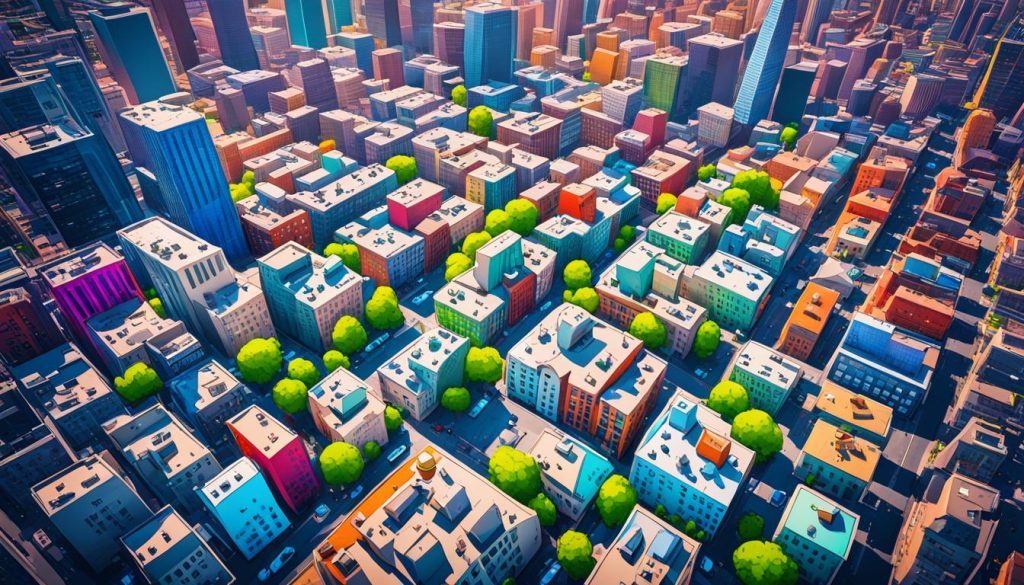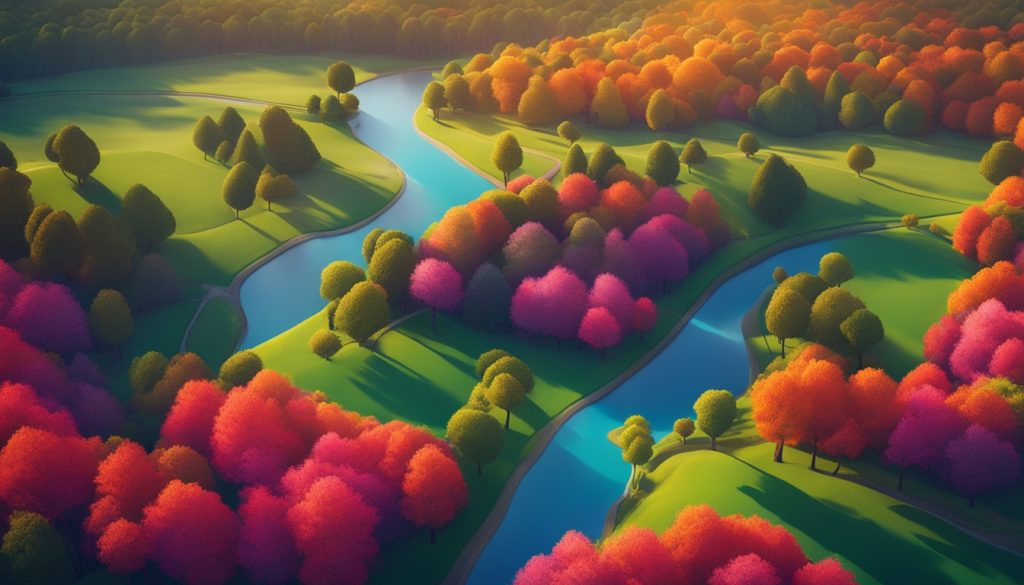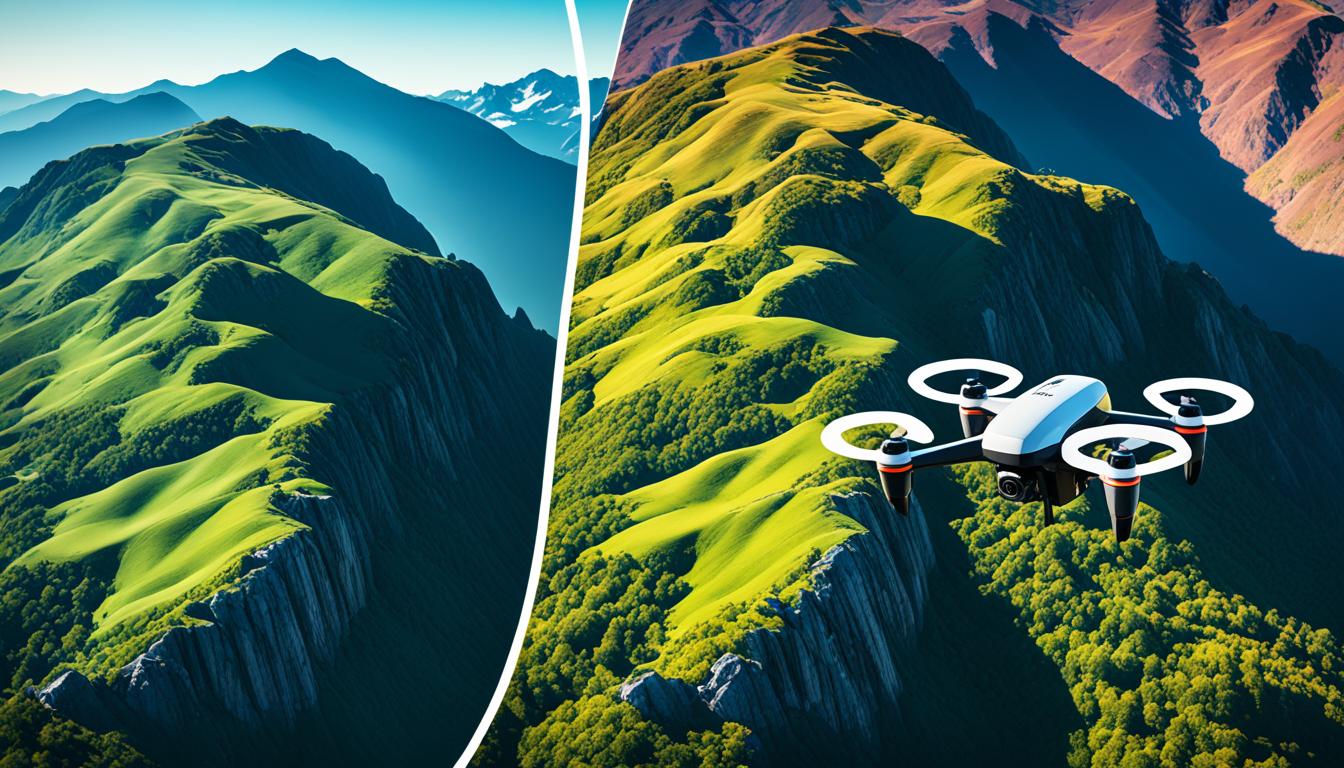Boost your aerial photography by using LUTs (Lookup Tables) for stunning color grading in vertical drone panoramas. LUTs are key tools that change your raw footage into visually appealing images. They make your drone cinematography more impactful.
LUTs are crucial for your post-production workflow. They help you keep color palettes consistent across your aerial shots. By using LUT presets, you’ll make editing easier and create vertical panoramas that grab attention in drone photography.
This guide will show you how to apply LUTs well. We’ll cover capturing the perfect vertical panorama and fine-tuning your color grading. You’ll discover how to use these tools to improve your aerial images and elevate your drone cinematography.
Understanding LUTs and Their Importance in Drone Photography
LUTs are key for color management in drone photos. They help you get amazing visuals and keep your drone shots consistent. Let’s look at LUTs and why they’re important for better aerial shots.
What are LUTs and how do they work?
LUT presets, or Look-Up Tables, change input colors to output colors. They set the color palette for your images, making it easy to add specific looks. Using LUTs means mapping color values to get the look you want.
The role of LUTs in standardizing color palettes
LUTs are great at making colors consistent across many images or videos. This is super useful in drone photography, where lighting changes a lot. With consistent LUTs, your drone shots will look the same, even if taken at different times or places.
Benefits of using LUTs in aerial photography
Using LUTs in your drone photos has many benefits:
- Time-saving: Apply complex color grades with a single click
- Consistency: Keep your project looking uniform
- Enhanced dynamic range: Show details in shadows and highlights
- Creative flexibility: Try different styles easily
Mastering LUTs can take your drone photography to the next level. You’ll create stunning, professional images that grab people’s attention.
Essential Camera Settings for Capturing Vertical Drone Panoramas
Mastering camera settings is key for great vertical drone panoramas. The right settings boost your aerial photography and drone cinematography skills. Let’s explore the must-know camera settings.
Begin by picking the right shooting mode. Full auto is good for beginners, but aperture priority or full manual gives you more control. Make sure to enable DNG RAW format in your DJI Go 4 app for top image quality and editing flexibility.
Turn on gridlines on your drone’s camera display. This helps get the right image overlap, usually 30-50%, for smooth stitching later. Keep your white balance the same in all shots for uniform colors in the final panorama.
| Setting | Recommendation | Purpose |
|---|---|---|
| Shooting Mode | Aperture Priority or Manual | Greater control over exposure |
| File Format | DNG RAW | Maximum editing flexibility |
| Gridlines | Enabled | Ensure proper image overlap |
| White Balance | Manual (e.g., Daylight) | Consistent colors across shots |
| ISO | Lowest possible (100-400) | Minimize noise in images |
Adjust your shutter speed based on the lighting. Faster speeds cut down motion blur, while slower speeds let in more light in dim places. Try different settings to find what works best for your vertical panoramas.
Preparing Your Drone for Vertical Panorama Shots
Getting ready for vertical panorama shots means setting up your drone right. The DJI Go 4 app has key settings for amazing results. Let’s look at the important steps.
Activating DNG RAW Mode
Open the DJI Go 4 app and go to Camera Photo settings. Turn on DNG RAW mode. This captures more image data, giving you more flexibility when editing. RAW files keep details in highlights and shadows, which is key for quality panoramas.
Enabling Gridlines
Turn on gridlines in your camera view. These help you get the right overlap when shooting. Aim for 30-50% overlap between shots. Gridlines are like guides, making sure each frame lines up perfectly with the next.
Setting White Balance
Choose a fixed white balance setting. This keeps colors the same in all your images. Don’t use auto white balance, as it can change colors between shots. Pick a setting that matches your lighting, like daylight or cloudy.
| Setting | Purpose | Impact on Panorama |
|---|---|---|
| DNG RAW | Capture more image data | Improved editing flexibility |
| Gridlines | Guide image overlap | Easier image stitching |
| Fixed White Balance | Maintain color consistency | Seamless color across panorama |
With these settings ready, your drone is set for stunning vertical panoramas. Remember, practice is key. Try these settings to see what works best for your drone and the conditions you’re shooting in.
Techniques for Shooting Vertical Panoramas with Your Drone
Mastering vertical panoramas is a key drone photography technique. By following these steps, you’ll capture stunning aerial shots that showcase expansive landscapes in remarkable detail.
Perfecting Image Overlap
For seamless vertical panoramas, aim for 30-50% overlap between shots. Use your drone’s gridlines as a guide. This overlap ensures smooth stitching in post-processing and eliminates gaps in your final image.
Top-Down Approach
Start your vertical panorama from the top and work downwards. This method helps maintain consistent exposure and reduces the risk of shadows changing as you shoot. For horizontal panoramas, begin at one end and move towards the other, keeping the same overlap principle.
Centering Specific Objects
When your panorama features a standout object, make it your first shot. Center this element and then move outwards, capturing surrounding areas. This approach ensures your focal point remains prominent in the final composition.
| Panorama Type | Starting Point | Direction |
|---|---|---|
| Vertical | Top | Downwards |
| Horizontal | Either End | Towards Opposite End |
By applying these drone photography techniques, you’ll create breathtaking vertical panoramas that showcase vast landscapes in incredible detail. Remember to practice and experiment with different scenes to refine your skills.
Post-Processing Workflow for Vertical Drone Panoramas
Creating stunning vertical drone panoramas is just the start. The post-production workflow is key to turning raw shots into amazing final products. Let’s look at the main steps in this process.
Begin by importing your RAW files into image editing software like Luminar 2018. This tool lets you make big changes while keeping the image quality high. Adjust things like exposure, contrast, and white balance for each photo.
Then, it’s time for panoramic stitching. Affinity Photo is great for this, offering advanced features to merge images smoothly. Make sure to focus on aligning and blending the images well for a smooth final look.
Save your work as 16-bit TIFF files to keep editing options open. This format keeps more color details than JPEGs, letting you make more changes later.
| Step | Software | Purpose |
|---|---|---|
| RAW Editing | Luminar 2018 | Basic adjustments and corrections |
| Panorama Stitching | Affinity Photo | Combining images into a seamless panorama |
| Final Export | Various | Creating shareable JPG files |
After you’re happy with your panorama, export it as a JPG for sharing. Each step in this workflow adds to your panorama’s quality. So, take your time and focus on the details.
Editing RAW Files in Luminar 2018 for Enhanced Quality
Luminar 2018 is great for editing RAW files, especially for drone photos. It helps you make your vertical panoramas look better before combining them.
Importing and Organizing Your Drone Images
First, import your DJI RAW files into Luminar 2018. Make a special folder for your vertical panorama project. This makes your work easier and keeps everything in one place.

Applying Basic Adjustments and Corrections
Once your images are in, start editing. Adjust things like exposure, contrast, and color temperature to get a balanced look. Make sure highlights and shadows are even across all your images.
Utilizing Custom Workspaces for DJI RAW Files
Luminar 2018 has special workspaces for DJI RAW files. These presets have tools just for drone photos. Try adjusting dehaze, clarity, and structure to improve your aerial shots. Find the workspace that works best for your style and your vertical panoramas.
Using these tips in Luminar 2018 will make your RAW files look better before you combine them into amazing vertical drone panoramas.
Merging Panorama Images in Affinity Photo
After editing your RAW files, it’s time to merge them into a stunning panorama with Affinity Photo. This software is great for stitching panoramic images. It lets you make seamless vertical drone panoramas easily.
To start, import your edited TIFF files into Affinity Photo. Go to the ‘New’ menu and find the panorama stitching tool. Pick your images and let the software do its thing. It uses advanced algorithms to line up and blend your photos into a panoramic image.
While stitching, watch out for any issues with alignment or ghosting. Affinity Photo has tools to fix these problems. You can adjust exposure, color, and perspective for a natural look.
Once your image is merged, use Affinity Photo’s editing tools to improve it. Adjust contrast, make selective edits, or use masks to highlight parts of your panorama.
The secret to great panoramic stitching is high-quality source images with good overlap. By shooting carefully and using Affinity Photo’s powerful tools, you’ll make stunning vertical drone panoramas. These will show off your aerial photography skills.
How to Apply LUTs for Stunning Color Grading in Vertical Drone Panoramas
Color grading your vertical drone shots can turn them into stunning visuals. Using LUTs is a great way to change the mood and feel of your photos. Let’s dive into how to use LUTs for amazing results.
Selecting appropriate LUTs for aerial photography
For aerial shots, pick LUTs made for drone photos. They should match the unique lighting and colors of the sky and ground. Try different LUTs to see which one fits your photo’s style best.

Adjusting LUT intensity and blending modes
After adding a LUT, adjust its strength to get the look you want. Start with a low setting and increase it as needed. Try blending modes like Overlay, Soft Light, or Color for unique effects. This lets you balance the LUT with your original photo.
Fine-tuning color grading with additional tools
Use more color tools with your LUTs. Adjust contrast and color balance with curves. Selective color changes can focus on certain parts of your panorama. Always aim for a subtle touch when refining your colors.
Mastering these methods will take your drone panoramas to the next level. You’ll create visuals that grab attention and highlight the beauty of aerial photography.
Advanced Color Grading Techniques Using ON1 Photo RAW
ON1 Photo RAW elevates color grading for your drone shots. It has many tools to make your aerial photos look amazing.
Sky Swap AI changes the game for drone photographers. It lets you swap dull skies for dramatic ones with just a click. You can turn overcast skies into stunning sunsets or starry nights.
The Effects module in ON1 Photo RAW has lots of filters to boost your photos. Dynamic Contrast adds depth, and the Sunshine filter adds warmth. The Color Enhancer tool helps fine-tune colors, perfect for landscapes.
ON1 Photo RAW works well with various plugins. You can easily switch between HDR, NoNoise, and Effects in one app. This makes editing faster and keeps your style consistent.
- Use Sky Swap AI for dramatic sky replacements
- Apply Dynamic Contrast for added depth
- Enhance colors with the Color Enhancer tool
- Utilize integrated plugins for a smoother workflow
Mastering these color grading techniques in ON1 Photo RAW can turn your drone shots into art. Try different Effects filters to find your style and make your photos pop.
Enhancing Dynamic Range and Reducing Noise in Drone Panoramas
Drone panoramas often struggle with limited dynamic range and noise because of their small sensors. We’ll look at how to fix these problems with tools like ON1 HDR and ON1 NoNoise AI.
Utilizing ON1 HDR for improved dynamic range
ON1 HDR is a big deal for drone photographers. It combines multiple shots to make high dynamic range photos. This tool lets you capture bright skies and dark shadows in one shot, fixing the issue of small drone sensors.
Applying ON1 NoNoise AI for cleaner images
Noise is a big problem in drone photos, especially in low light. ON1 NoNoise AI uses smart algorithms to cut down noise while keeping details sharp. This makes your drone panoramas look professional and clear.
Balancing detail retention and noise reduction
It’s key to balance detail and noise reduction for top-notch drone panoramas. ON1’s tools let you adjust these settings. This way, your images stay sharp and clear, even in tough lighting or high ISO shots.






